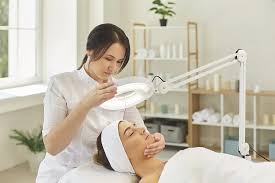Stories you may like
Esthetician Job Role
Estheticians are state-licensed skincare professionals who provide cosmetic treatments like facials, acne care, exfoliation, peels, spray tanning, hair removal, and makeup application. Their work focuses on enhancing the health and appearance of the skin through tailored approaches.
Demand for estheticians is growing rapidly, with over 60,000 professionals in the U.S. and a job market expanding faster than the national average.
While they work at the intersection of beauty and wellness, they are not medical practitioners and focus solely on non-medical skin treatments.
What Is an Esthetician?
An esthetician is a licensed skincare professional who provides non-medical treatments to enhance skin health and appearance. Their services include facials, exfoliation, hydration, and targeted treatments for concerns like acne or hyperpigmentation.
While they do not diagnose or treat medical skin conditions, estheticians specialize in cosmetic and preventative skincare. They often work in spas, salons, and medical settings, sometimes collaborating with dermatologists to complement medical treatments.
Job Description
Estheticians focus on enhancing the skin’s tone, texture, and overall vitality while addressing concerns like sun damage and aging. Their expertise extends beyond the face to include skincare treatments for the neck, hands, feet, and body.
Despite the common use of terms like "medical aesthetics," estheticians are not medical practitioners. They cannot:
- Diagnose skin conditions
- Prescribe medications
- Recommend treatments beyond cosmetic skincare products
Because their work is limited to the skin’s superficial layers, estheticians do not perform injectables like Botox, facial fillers, or deep chemical peels.
These procedures, along with the diagnosis and treatment of medical skin conditions, fall under the expertise of licensed medical professionals, such as dermatologists.
Consultations and Recommendations
A key part of an esthetician’s role is conducting in-depth consultations to assess a client’s skin and create a tailored skincare plan.
The process begins with a detailed discussion about the client’s skin concerns, lifestyle, diet, medical history, and current skincare routine. The esthetician then performs a skin analysis, which may involve:
- Visual inspection: Examining skin tone, texture, and conditions like acne, dryness, or hyperpigmentation
- Touch assessment: Feeling the skin’s elasticity, hydration levels, and oil production
- Magnification and Woods lamp: Using a magnifying lamp or a Woods lamp (UV light) to detect underlying skin issues such as sun damage, clogged pores, or dehydration
Based on their findings, the esthetician provides professional treatment options, recommends at-home skincare routines, and suggests suitable products. They also educate clients on proper skincare techniques and potential lifestyle changes to improve skin health over time.
Common Treatments
Estheticians help clients enhance their skin’s appearance and address non-medical concerns through a variety of non-invasive treatments. The treatments an esthetician offers depend on their training, certifications, and workplace.
While each spa or clinic has its own menu, common services include:
- Facials: A signature treatment in esthetics, facials involve cleansing, exfoliation, hydration, and sometimes massage. Each facial is customized to address concerns like acne, dryness, or aging.
- Extractions: This process manually removes blackheads and pore buildup to improve skin clarity and prevent breakouts. It is often included in facials for deeper cleansing.
- Acne treatments: Mild acne can be managed with exfoliation, extractions, and skincare recommendations. For more severe cases, estheticians may work alongside dermatologists to complement medical treatments.
- Microdermabrasion: This non-invasive exfoliation technique uses a diamond-tip wand or fine crystals to smooth skin texture, reduce fine lines, and even out tone.
- Chemical peels: Superficial peels with acids like glycolic or salicylic acid help brighten skin, fade dark spots, and promote cell turnover. Regular treatments offer anti-aging and acne benefits.
- Body treatments: Scrubs, wraps, and masks exfoliate, hydrate, and soften the skin. These treatments are designed to refresh and revitalize areas beyond the face.
- Hair removal: Waxing, threading, and tweezing are common services for removing unwanted hair. Advanced certification allows estheticians to perform laser hair removal.
- Airbrush tanning: With this sunless tanning method, a fine mist is applied for a bronzed glow. Results last up to two weeks and gradually fade.
- Makeup application: These services are often booked for weddings, proms, and photoshoots, using professional techniques and products for a polished look.
- LED light therapy: Different LED light colors target concerns like acne, redness, and fine lines. Often combined with facials to enhance skin health.
- Laser resurfacing: This treatment improves skin texture and reduces wrinkles using fractional laser technology. Requires specialized certification.
- Thermage and CoolSculpting: Advanced non-invasive treatments tighten skin (Thermage) or reduce fat (CoolSculpting). These procedures require additional training and certification.
Many of these treatments are covered in basic esthetics training, but advanced procedures like laser treatments and deep chemical peels need extra training and certification. Learning more skills helps estheticians offer more services and grow in their careers.
How to Become an Esthetician
Becoming an esthetician requires completing a formal training program and earning a state license. The general steps include:3
- Education: Enroll in an accredited esthetics program, usually offered at beauty schools or community colleges. These programs cover skincare techniques, sanitation, anatomy, and product knowledge. Training hours vary by state but generally range from 300 to 1,500 hours.
- Hands-on training: Most programs include practical experience where students work on real clients under supervision.
- Internship: Before graduating, many students complete an internship to gain real-world experience in a spa, salon, or medical setting. This allows them to refine their skills and learn how to interact with clients professionally.
- Licensing exam: After completing the required training hours, graduates must pass a state board exam, which usually includes both written and practical (hands-on) components.
- Continuing education: Some states require ongoing education to maintain licensure and stay updated on new techniques and regulations.
Estheticians must be licensed in all 50 states, with licensure handled by each state's Board of Cosmetology or Department of Health.
After getting their license, estheticians keep learning through extra training to stay up to date on new skincare techniques. Some states recognize master estheticians—those with advanced skills.
Estheticians who want to work in medical settings like doctor’s offices, medical spas, or hospitals can specialize in medical esthetics. Those who train in oncology esthetics learn how to safely care for people going through cancer treatments that affect their skin.
Types of Estheticians and Where They Work
Estheticians specialize in various aspects of skincare and work in diverse settings, including spas, salons, medical offices, and independent businesses. Their expertise determines the treatments they provide and where they practice.
- Beauty therapists: Offer a full range of skincare and wellness treatments, often in luxury spas, high-end salons, or private studios. Their services may include facials, massage, body treatments, and holistic skincare therapies.
- Master estheticians: Receive advanced training in treatments like chemical peels, microdermabrasion, LED therapy, and laser procedures. They typically work in medical spas, dermatology clinics, or advanced skincare centers.
- Hair removal specialists: Focus on waxing, threading, and laser hair removal, providing services in salons, spas, or specialized hair removal centers
- Licensed estheticians: General skincare professionals offering facials, extractions, and customized skincare treatments in salons, spas, or wellness centers. They also educate clients on skincare routines and products.
- Medical estheticians: Work in dermatology offices, plastic surgery clinics, and medical spas, supporting medical professionals with post-procedure care, acne management, and scar reduction. However, they do not perform medical treatments themselves.
- Waxing specialists: Specialize in body and facial waxing, performing hair removal services in salons, waxing studios, or beauty spas
- Skin care consultants: Advise clients on skincare routines and products, often working for beauty brands, cosmetic retailers, or independently as freelance advisors
Many estheticians keep learning new skills by taking extra training and special courses. This helps them offer more treatments and grow in their careers.
Esthetician vs. Cosmetologist
Although estheticians and cosmetologists both work in the beauty industry, their areas of expertise are distinct.
Estheticians specialize in skincare, offering services such as facials, waxing, and advanced skin treatments. However, they do not cut, style, or color hair.
Cosmetologists have a broader skill set that includes hairstyling, nail care, and makeup, along with some basic skincare treatments. While they receive more extensive training in hair care, their skincare education is less in-depth compared to estheticians.
How Much Do Estheticians Make?
Esthetician salaries vary widely depending on specialization, location, and experience. According to ZipRecruiter, in 2025, salaries for estheticians and related professionals range from $20,000 to $155,000 per year.
- Highest earners: Beauty therapists earn between $85,000 and $155,000 annually, making them the top-paid professionals in the field.
- Mid-range salaries: Master estheticians ($46,000–$77,500), hair removal specialists ($53,000–$59,000), and licensed estheticians ($38,000–$78,000) fall within this bracket, with those working in high-end spas or medical settings typically earning more.
- Lower-range salaries: Skin care consultants ($20,000–$33,500), waxing specialists ($35,500–$52,000), and medical estheticians ($36,000–$56,000) tend to earn less, though experience and clientele can significantly impact earnings.
While it may seem like medical estheticians would earn more, their lower salary range may be due to stricter regulations, limited treatment options, and the fact that they often work under medical supervision rather than running their own businesses.






User's Comments
No comments there.